Getting a dart frog is just the perfect option for adding more color to your life. Petting these tiny frogs is such an easy experience that they’re highly sought after by frog owners.
To own a dart frog, you have to provide them with a beautiful naturalistic, functional, and comfortable habitat. The dart frog habitat setup requires a long list that includes a tank, moss, lighting, water pump, plants, misting system, glass cover, substrates, etc. Sounds like a lot of work? Not at all, you just need to know what to do.
In this blog, I will help you to know about the dart frog habitat setup. Which will surely serve your purpose in making the dart frog terrarium.
What is required for a dart frog vivarium/Terrarium?
Every setup needs a pre-checklist and the dart frogs tank setup is no exception. You need all the following items to complete the whole setup…
- Glass tank
- Moss
- Glass cover
- Substrate
- Suitable & safe plants
- Hydroballs
- Lighting system
- Distilled water or bottle spring water
- Thermometer
- Hygrometer
- Bio bag
- Water pump
- Heatmat
- Hiding item & shelters
- Micro Fauna
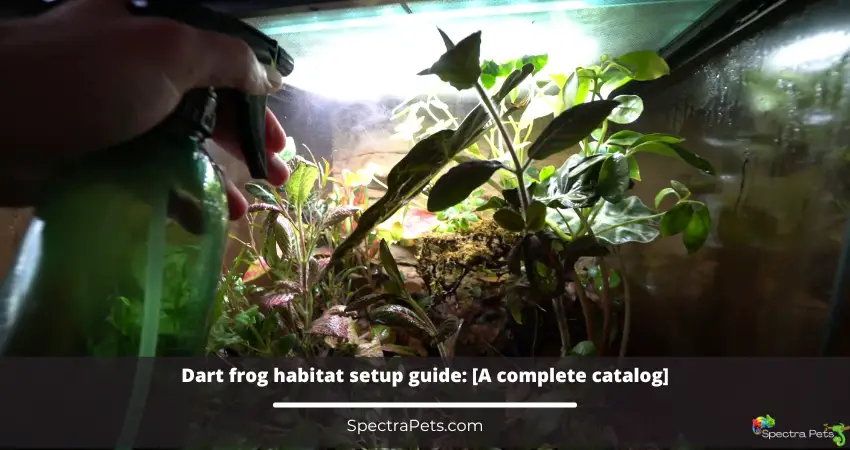
Step by step guide for dart frog terrarium setup
Tank setup process is indeed a time taking process. Still, you will feel a great relief the moment you are done with it. You will be amazed at the scene where the multicolored dirt frogs will be moving here and there.
So without further ado, let’s jump to the main steps….
Step 1 : Select the right size terrarium
The first thing you need is a terrarium to build a comfortable and natural habitat for your dart frogs. So knowing the appropriate size of your terrarium is crucial.
What size tank is required for poison dart frogs?
When it comes to choosing the tank size, it depends on multiple factors which include the number of dart frogs, age group of dart frogs, and the species of dart frog.
The clear-cut rule is you need to provide 5-10 gallons amount of space for a single dart frog. It is possible to keep multiple of them when they are babies, but when they reach the fertility stage, they need more space.
Have a glimpse to find out what size is fitting for your needs…
| Dart frog numbers | Terrarium size |
| 1 adult dart frog | 10 gallons (12x12x12’’) |
| A pair of Bumblebee dart frog | 12x12x18’’ |
| 3 adult dart frogs ( 1 male, 2 female) | 18x18x24’’ |
| 3-5 adult Golden Poison Dart frogs (1male+2 female, or 2male+ 3 female) | 36x18x24’’ |
When you have plan to keep more than 5 dart frogs, you should go for a 75 gallant tank that would allow the dart frog to roam around freely.
The most important thing is the floor size. A bigger floor is a must for dart frog groups. In terms of keeping these magnificent amphibians together always keep the female number higher than the male frog.
Read Also: How Big Do Dart Frogs Get?
Step 2 : Select The Right Spot And Clean The Tank
Now it’s time to put the terrarium into your selected place. Choosing the right spot is crucial as it won’t be possible to move it often after the final setup. A few pre-works are mandatory before the final setup process of the dart frog terrarium which is following…
Wash & thoroughly rinse the tank and every single material that is going to be inside the terrarium. This list includes plants, hydro-balls, etc. Avoid using tape water and chemical cleaner for the cleaning process. Wash everything with distilled water or bottled spring water.
Soak the moss to ensure it’s damp and also soft enough for the frogs’ comfort.
Step 3 : Adding the pump
Though a water pump is not mandatory, it will help a lot. If you install a submersible pump then you do have to change the water frequently. Because it will pump the excess water.
Let’s see how to set up a pump inside the beautiful frog terrarium..
Start with keeping the pump inside a bio bag. It will help the pump to not get clogged by moss. After that, create a tiny hole in the bag & attach a hose pipe through this hole.
Now fix the pump on the exact opposite side of the water feature. Then tie off the open end of the bio bag with a zip tie. Cut the excess plastic tail from the zip tie.
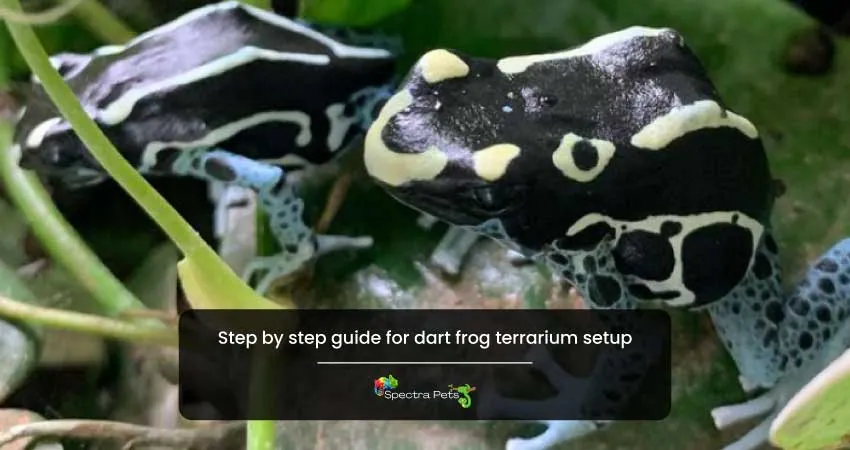
Step 4 : Maintaining Temperature
The right temperature will ensure the right growth. They feel good when the temperature remains between 75-84 degrees Fahrenheit. Though a little bit up down is not a big deal but a long time of exposure to unusual temperatures can make your dart frog sick. It can even die.
Buy an excellent digital thermometer to monitor the temperature. If your room temperature meets their required temperature then you don’t need a heating mat. However, if you belong to a cold region then you may need this to ensure the right temperature.
Step 5: Provide the perfect humid environment
These frogs just love humid environments. You have to maintain a high 80-100% humidity level inside the enclosure and that’s not very hard to do.
The combination of the right amount of moss, proper substrates, ample amount of misting & glass cover will make it happen. A long-lasting & quality hygrometer can be very useful for measuring humidity and also temperature.
Step 6: Adding substrate
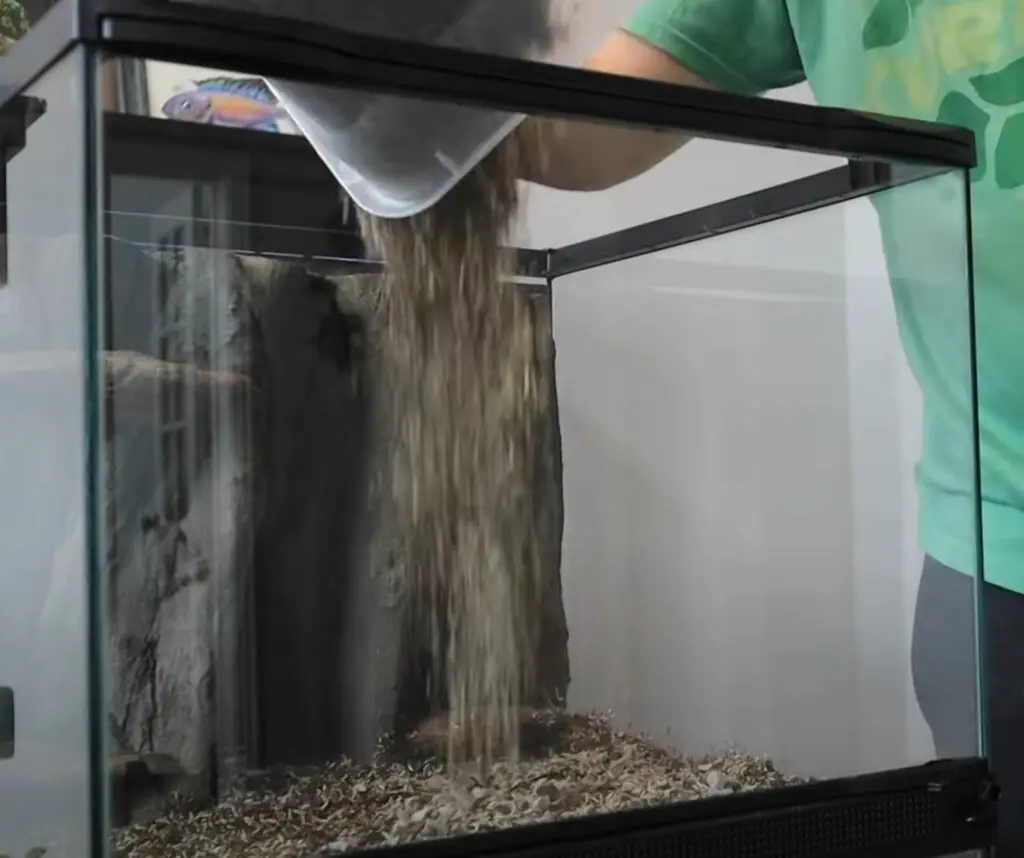
If you’re thinking about setting up a dart frog habitat, you might be wondering what the best substrate is. There are a few different options available, and in this blog post, we’ll go over some of the most popular substrates used for dart frog habitats.
Mixed Substrate
ABG Mix is a popular choice for dart frog substrates. It’s a blend of peat moss, coco fiber, sphagnum moss, and perlite. This substrate holds moisture well and provides a naturalistic look for your dart frog habitat.
It’s long-lasting and bio-balanced. That means that you won’t have to replace it as often, and your frogs will stay healthy and happy.
Leaf Litter
Another popular substrate choice is leaf litter. This can be collected from your yard or purchased from a pet store. Be sure to only use leaves that have not been treated with chemicals! Leaf litter provides a more naturalistic look for your habitat and also holds moisture well.
Coconut Fiber & Coco Husk
Coconut fiber and coco husk are also popular substrate choices for dart frog habitats. They hold moisture well and provide a naturalistic look.
Soil Substrate
Soil can also be used as a substrate for dart frogs. Be sure to use sterile, chemical-free soil! Soil holds moisture well and provides a naturalistic look for the frog’s habitat.
If you have plants to keep fake plants then a very soft and safe layer of substrate is required. Because draining excess water is crucial for a perfectly working vivarium climate.
Moreover, the false bottom would be perfect for collecting excess water. Hydro-balls would be the best pick for when it comes to the false bottom.
Let’s have a quick look at some important tips for adding substrate…
- Place the pre-soaked moss over the hydro-balls layer.
- Slowly add the substrate until you’ve reached the desired depth. For most setups, the recommendation is a depth of 2-4’’.
- To maintain an appropriate humidity level, your dart frog substrate has to be moist enough. However, dripping wet would be a complete disaster.
- After adding the desired amount of substrate, it’s important to compact it slightly. This will help to prevent problems like pockets of space which can lead to problems with drainage. To compact the substrate, simply press down on it lightly with your hand or a small object like a book.
- You can also add a drainage layer for cutting off extra hassle.
Step 7 : Adding Plants
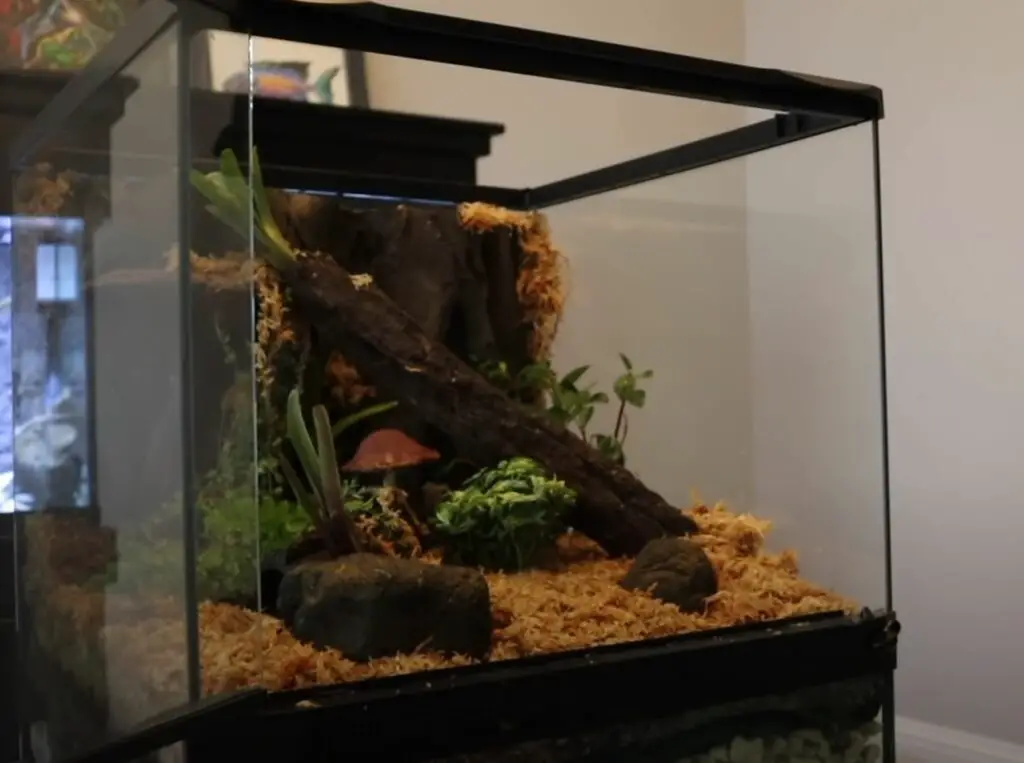
Including a variety of plants in your dart frog’s enclosure will also help to make it look more natural and inviting. To achieve a bioactive ecosystem, which is self-sustaining, plants are mandatory.
Live plants play a crucial role in maintaining humidity levels, providing hiding places, and producing fruit or leaves that these frogs can eat.
Here are some of our favorite plant choices for poison dart frog tanks:
Snake plants
Snake plants are a great option for beginner hobbyists because they are very easy to care for. These plants are also excellent at absorbing excess water and helping to regulate humidity levels inside the enclosure.

If you choose to include a snake plant in your poison dart frog’s habitat, make sure that it is properly potted so that the roots are not exposed.
Ferns & Bromeliads
Ferns and bromeliads are another good option for poison dart frogs. These plants help to create a naturalistic-looking habitat while also providing hiding places for your frogs.
Bromeliads also produce pupae, which are an important food source for many species of poison dart frogs. When selecting ferns and bromeliads for your enclosure, make sure to choose species that are safe for reptiles and amphibians.
Anthuriums & Caltheas
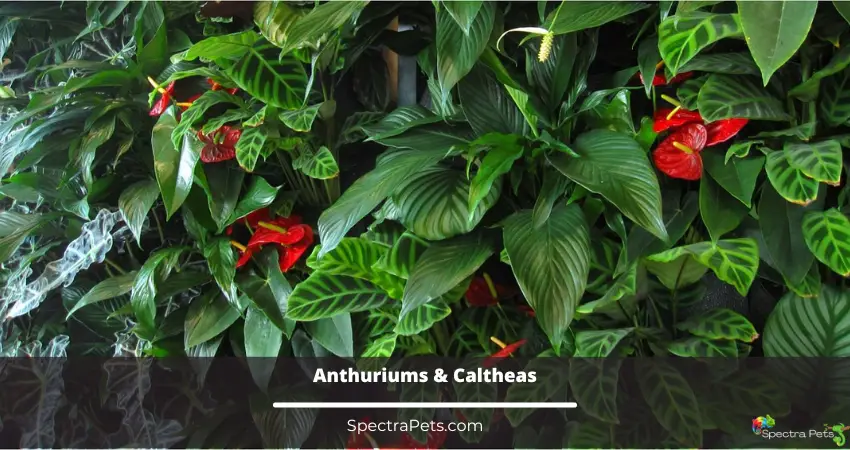
Anthuriums, calatheas, and other similar plants are often used as houseplants but they can also make great additions to poison dart frog habitats. These plants help to create a humid environment inside the enclosure while also providing hiding places for your frogs.
Pileas & Selaginellas
Pileas and selaginellas are two more great options for poison dart frog habitats. These plants keep the tank’s climate dart-frog friendly. Pileas can also produce fruit that your frogs may enjoy eating.
Step 8: Adding hiding spot
Dart frogs are shy creatures that spend most of their time hidden from view, so these hiding spots are essential for their survival.
Cork bark and clay flower pots can provide ideal hiding spots for dart frogs. The cork bark offers a natural camouflage that allows the frogs to blend in with their surroundings, while the clay pots provide a safe haven from predators. Clay flower pots can be turned upside down and used as simple shelters.
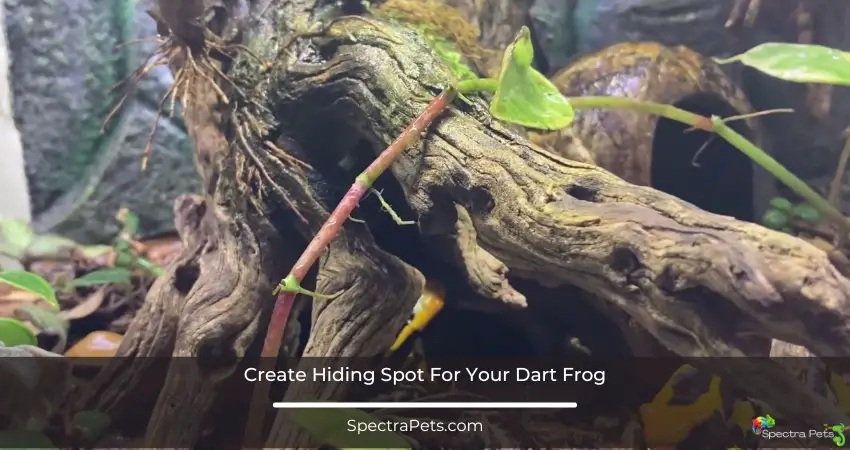
Driftwood also helps to create a more naturalistic habitat for dart frogs, which can make them feel more at home. When choosing driftwood for your dart frog enclosure, be sure to select pieces that are free of toxins and have smooth surfaces to prevent injury.
Step 9: Adding lighting system
Without proper lighting, the setup will remain incomplete. Just like wild frogs, your pet dart frog needs to have an idea of the day and night cycle. It’s extremely important for their healthy development.
It would be best if you set up the lighting system for 12 hours on and 12 hours off. For lighting of dart frog, you don’t need to set up a UVB light. But you have the option to add if you want.
Moreover, for the perfect growth of the plants of your dart frogs habitat, an ample amount of lighting is a must. For a 10-15 gallon tank, you can use 20-watt bulb light.
Related Post: Do Dart Frogs Need UVB? [Read More]
Step 10: Misting the dart frogs habitat
As your dart frog requires high humidity a proper misting system would keep things under control. The whole environment needs to be misted thoroughly with a fogger, which includes substrates, plants, and branches.
Misting the tank 2 times for 5 to 10 seconds would be perfect for maintaining the proper humidity level.
Step 11: Introducing the frog to the new habitat
In this step all you need is a bit of patience. When setting up a new terrarium for your dart frog, it is important to take some time to acclimate the frog to its new surroundings. Introduce the frog to the terrarium.
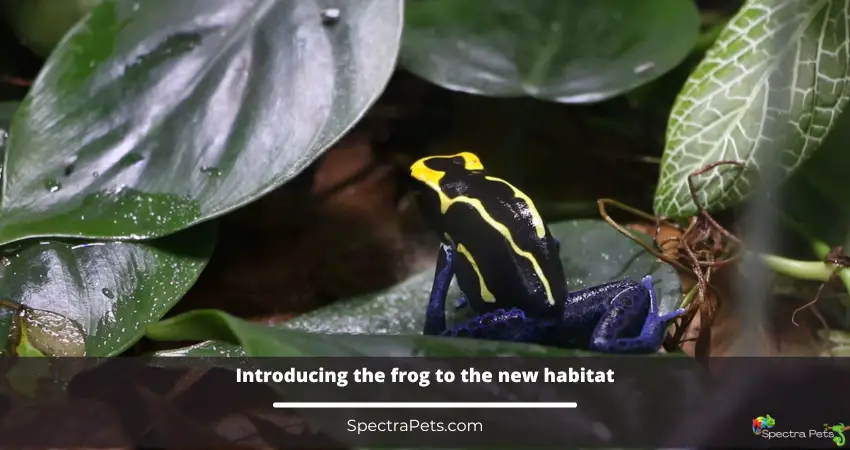
You can keep them in a container and then put them inside the tank. Then give the little buddy a few hours and slowly it will start to adapt to the climate.
Once the frog feels stressed-free and adjusted to its new home, it will automatically jump out and roam around the new habitat.
Step 12: Adding the glass lid
Though a cover like a glass lid is not mandatory for a dart frog vivarium. But a full glass cover will ensure that the humidity level stays at the accurate level.
Dart frogs are excellent climbers so the glass lid will stop the frog from getting outside the terrarium.
How to know a terrarium is ready for keeping dart frogs?
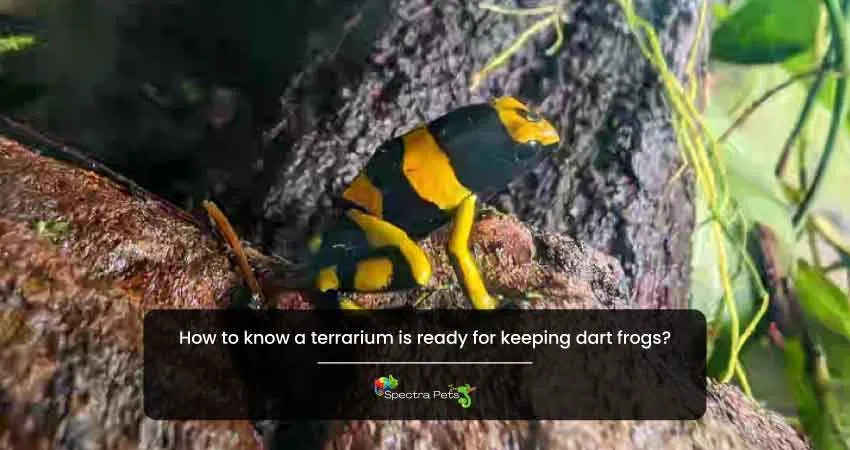
Some specific conditions have to be present before you keep the dart frog inside your terrarium. If you find those conditions are met then you can start the process of adding frogs into the tank.
Let’s have a look at those…
- Take a hygrometer and measure the humidity inside the terrarium. If it shows something between 80-100%, you can add the frogs one by one.
- Check the internal temperature of the tank where the frog gonna live. Use a high-quality digital thermometer for this. The temperature has to be within 75-84 degrees Fahrenheit for the frogs comfortable living. If it falls in this range, it’s time to keep the frog inside the terrarium
- Look for any unwanted gaps, small/big holer, and any signs of a crack on the wall of the tank.
- Ensure the substrate layer is a bit wet before adding the colorful buddies.
- Examine the plant’s roots carefully. It has to be rooted strongly. So, you can test it by tugging the roots of the plant. If it shows good resistance that means it’s perfectly done.
- If you notice any algae growth inside the enclosure, immediately scrub it using a paper towel. Then it’s safe for the dart frog inside the tank.
- Make sure there is microfauna in the terrarium which is highly beneficial for dart frogs.
FAQs
What temperatures do dart frogs like?
Poison dart frogs would be best in the mood when the terrarium’s temperature remains between 75-84 degrees Fahrenheit.
How hard is it to keep dart frogs?
Compared to other sensitive frogs, dart frogs require less maintenance and care. The best part is you don’t need to remove their poop regularly. Monthly cleaning of the tank would be enough.
Can you keep a single dart frog?
Yes, you can keep only one dart frog. But it would be better if you kept them as pairs because they are okay with living in groups.
How much space does a dart frog need?
Most frog experts suggest that you should keep a minimum 5-10 gallon amount of space for each dart frog inside the terrarium.
How many dart frogs can you keep together?
If you want to keep multiple dart frogs inside one tank then the tank size has to be big enough for their free moving and it should have enough hiding spots too. You can keep 2-5 adult dart frogs in one take but it has to be around 70-gallon tank.
You may be interested in my other article, ‘’How many dart frogs can you keep together?‘’.
Is tap water suitable for dart frogs?
No tap water is not suitable for dart frogs at all. You need to use distilled water or bottled spring water for dart frogs.
What should be the humidity level of the dart frog tank?
For healthy growth & optimum body function, the humidity level of the dart frog tank has to be 80-100%. If the humidity falls too low then it will become sick.
How To Easily Maintain The Humidity Level Inside The Dart Frog Tank?
A misting machine like a fogger would be excellent to maintain the humidity level at the highest level. Simply 2 times spraying only for 15-20 seconds would be enough to keep the humidity level high. Also, use a glass cover/lid for the tank to keep the humidity level perfect and stop the dart frog from escaping the enclosure.
Wrapping up
Give your dart frog proper care and enjoy their company for the next 8-15 years. You saw what the setup of the dart frogs tank look like.
Let me remind you that in terms of keeping frogs and plants you can bring a variation. Hopefully, this post will be your guideline for building the dart frog habitat setup.
